Pelargonium peltatum
Fast growing and brightly colored, ivy leaf geraniums take center stage in any hanging basket arrangement.
In the family Geraniaceae, Pelargonium peltatum is commonly known as ivy leaf, trailing, or cascading geranium.
An herbaceous perennial native to South Africa, P. peltatum was introduced to the cool climates of Holland and England by 1704. Winter hardy only in Zones 9-11, their fast growth and easy propagation soon saw them being used as an annual – as they still are today.
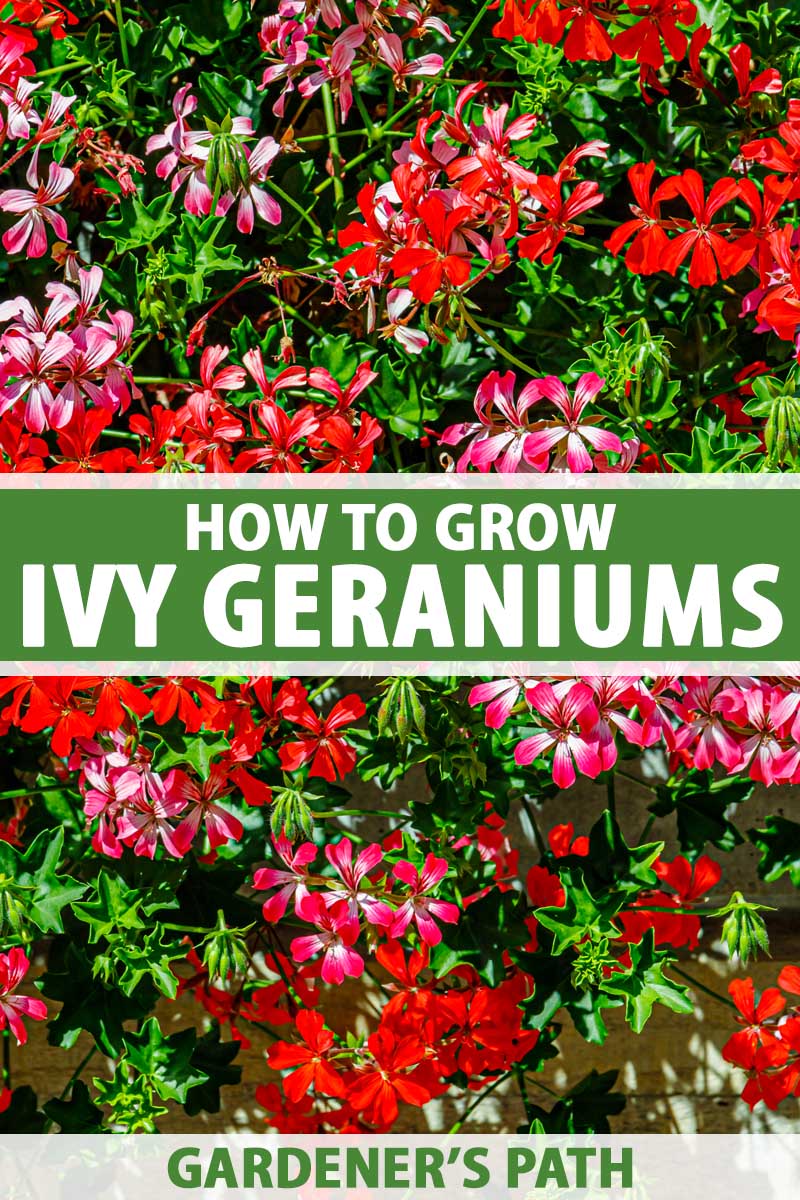
We link to vendors to help you find relevant products. If you buy from one of our links, we may earn a commission.
With prolific growth patterns, plants can have a dramatic spread of up to six feet, and they bloom all summer long in cascades of vibrant color.
Bright green, five-lobed leaves are similar in shape to that of ivy, with some varieties having variegated foliage with flowers that bloom in shades of apricot, burgundy, lavender, orange, pink, purple, red, and white.
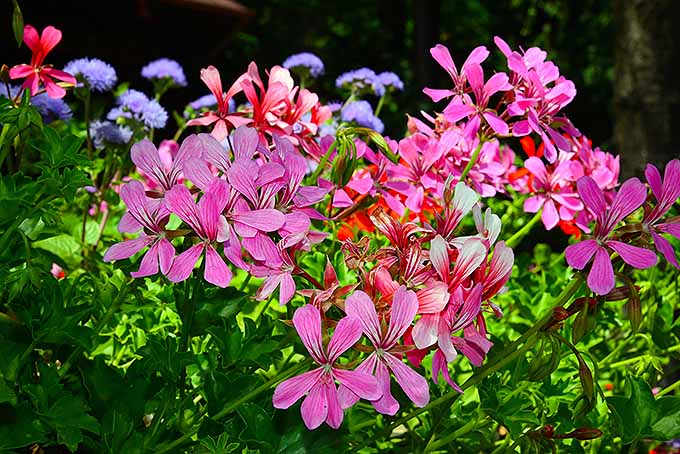
With growth habits that climb, creep, trail, and spread, they make a dazzling addition to Mediterranean gardens, beds and borders, window boxes, hanging baskets, planters, containers, and may even be used as a ground cover in warm climes.
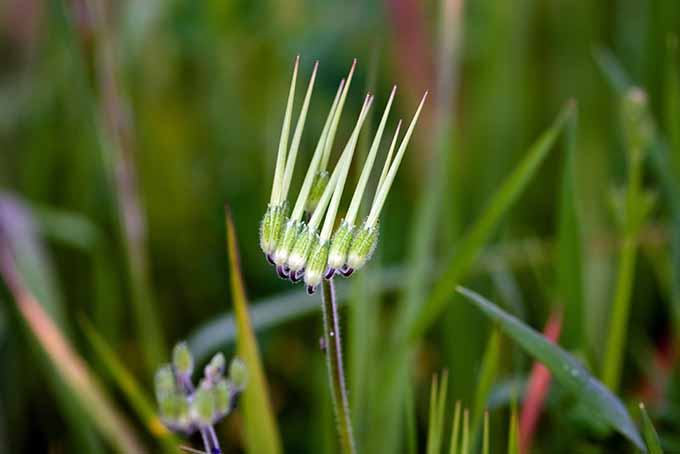
Flower heads are arranged in umbel-shaped clusters known as “inflorescence” that are looser in shape and density than those of zonal varieties.
Pelargonium comes from the Greek word pelargos or stork. And like its close cousins, the garden geranium and the cranesbill geranium, the set fruit resembles that of a stork’s beak.
Growth Habits by Variety
Increasingly popular for the home garden, over 75 commercial cultivars of ivy geraniums are available in a variety of growth habits, colors, and plain or variegated foliage.
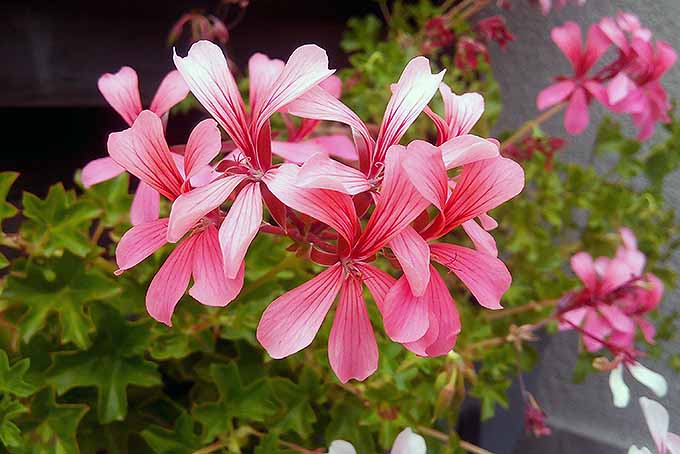
Some varieties have been developed to withstand hot temperatures, and some are also “self-cleaning,” meaning they never need to be deadhead.
Here are the four main types to know about:
Traditional
Traditional ivies sport large double- or semi-double flowers with thick, fleshy leaves.
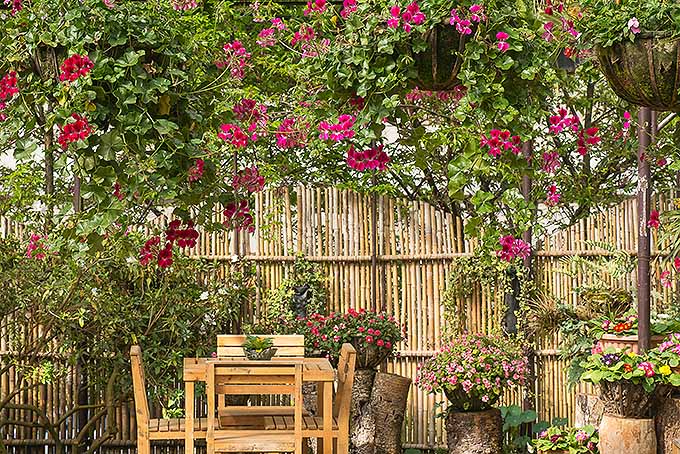
Flowers are showy, but usually less abundant than the cascade varieties.
Cascade/Balcony
Cascade or balcony types have numerous single flowers with small green or variegated leaves.
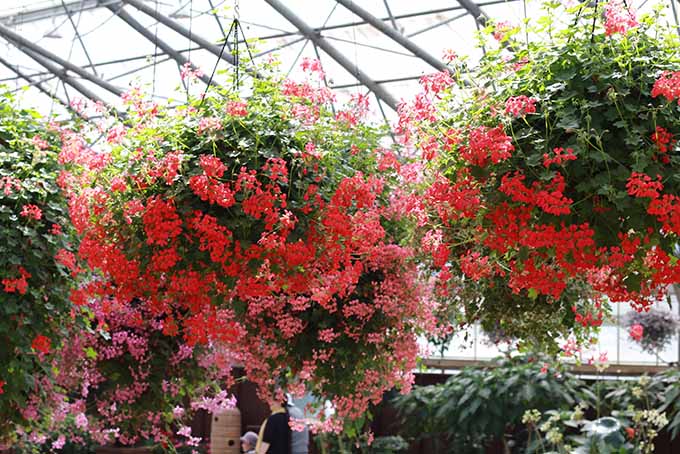
Cascades branch readily and tend to be more compact than the traditional cultivars.
Miniature and True Dwarf
Mini cascades and true dwarf forms are much like cascades, but have a tighter, more compact growth habit.
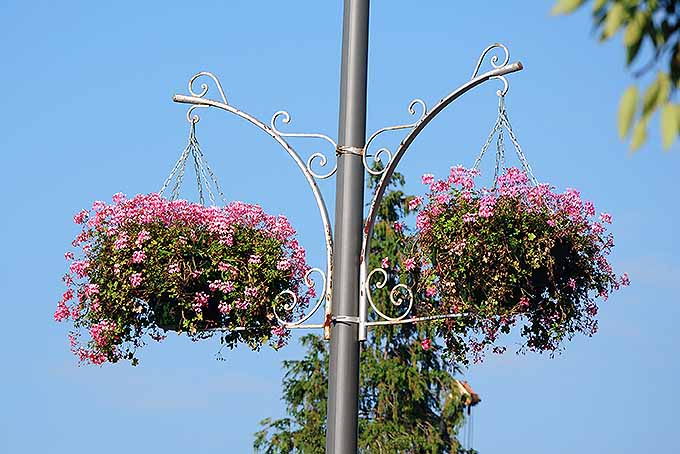
They also feature slightly smaller and less prolific flowers.
Ivy-Zonal Hybrids
Ivy-zonal hybrids have combined the flowers and leaves of zonal varieties with the vining habit of the ivies.
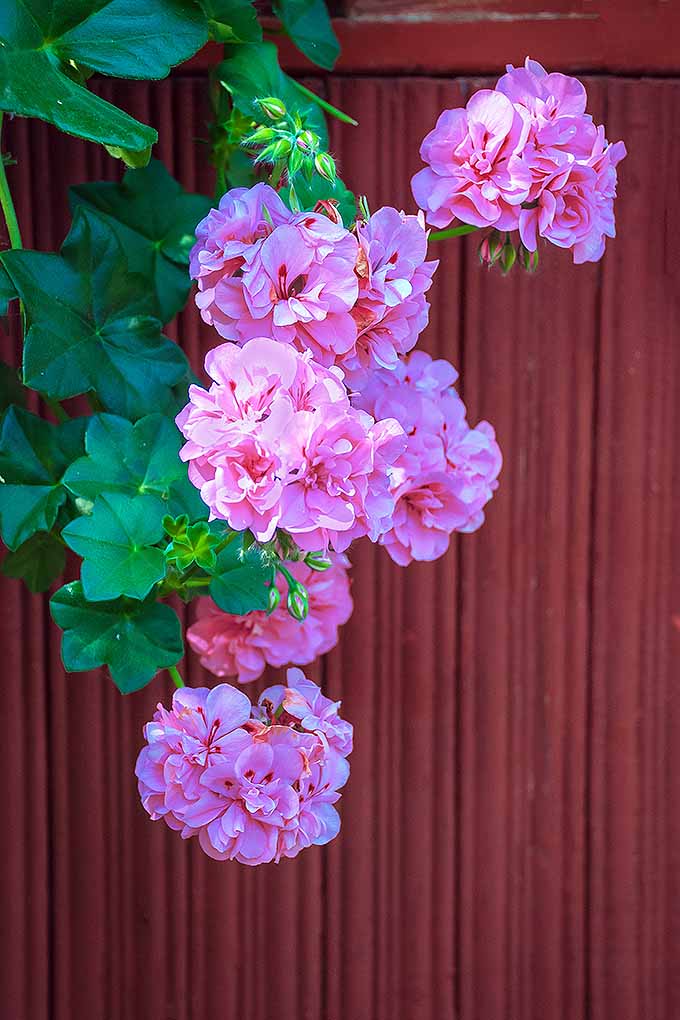
Flowers are semi-double and compare in number to traditional and zonal types.
Where to Purchase
Ivy geraniums can be purchased at your local garden center in the spring and summer, or you can readily purchase seeds and stock online.
Try a package of 10 mixed-color, heat tolerant seeds from Outsidepride, available via Walmart.
Or, for something clean and simple, try these all-white seeds from Outsidepride, available via Amazon.

Outsidepride White Ivy Leaf Geranium, 10 Seeds
Once you have your seeds or stock, it’s planting time!
Starting from Seeds
Geraniums can be grown from seeds, transplants, or cuttings.
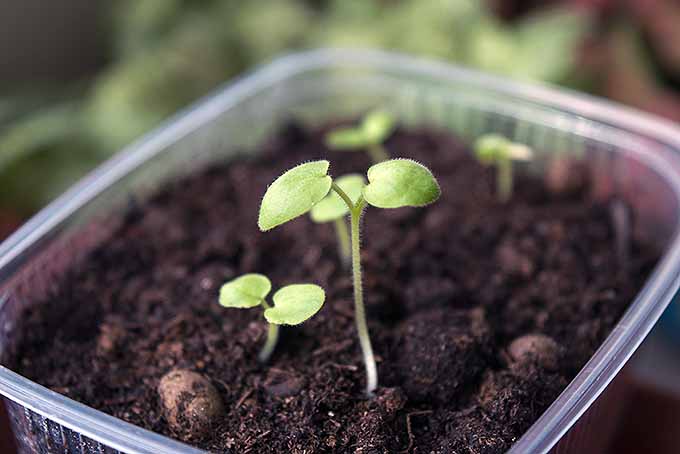
Slow growing from seed, they need to be started indoors early, in mid- to late January.
Here are the steps to follow:
1. Dampen a couple of paper towels, then spread seeds over half of the surface. Fold the other half over top of the seeds.
2. Place the damp, folded towels into a zip-top bag to retain the moisture, and seal the bag. In 24-48 hours, seeds will begin to germinate.
3. Fill clean, small pots or trays with a light starter soil mix to about 1 inch from the top.
We like the organic and sustainable coconut fiber wafers that expand with water, like these from Window Gardens that make 12 quarts of soil, available via Amazon.

4. Sow seeds and cover with another 1/4-inch of soil.
5. Mist the top of the soil with a spray bottle and set containers in a saucer of water to absorb water from the bottom.
6. Provide bright light and steady temperatures of at least 60°F for the seedlings, and maintain moist, but not wet, water levels.
7. Once plants reach a height of 3-5 inches, transplant to larger containers or plant in the ground in the garden.
From sowing seeds to flower blooms, this will take approximately 12-16 weeks. A faster propagation method is to start new plants from stem cuttings.
Stem Cuttings for Easy Propagation
All pelargoniums, including ivy geraniums, are among the easiest plants to propagate from cuttings. These can be taken in late autumn, or just before the frosts arrive in your region.

Here are some tips to keep in mind to start strong, healthy new plants:
1. Choose a mature, healthy plant to take cuttings from.
2. With a sharp, sterile knife, take several cuttings 4-5 inches in length, cutting just above a strong set of healthy leaves.
3. Except for the top 2-3 leaves, remove all blooms, buds, and remaining leaves from the stem.
4. Allow cuttings to rest, out of direct sunlight, for a couple of hours or just until the cut end starts to form a callus.
5. Fill small containers to 1 inch from the top with a light potting soil.
6. Place the containers in a saucer or tray filled with lukewarm water, and allow the soil to drink from the bottom until the surface feels moist but not wet.
7. Discard the excess water and allow containers to drain freely.
8. Moisten the cut tips in water, then dip into a powdered rooting hormone if desired.
9. Set the cuttings into the soil 1-3 inches deep, and firm soil lightly around each stem.
10. Place your containers in a bright location out of direct sunlight for 2-3 weeks, to allow roots to form. Keep the soil evenly moist, but not soggy.
11. After 2-3 weeks, a gentle tug to the stem and ensuing resistance will tell you whether roots have formed.
12. Once roots are established, move cuttings to a sunny location and maintain even moisture levels.
13. Transplant to permanent containers or into the garden after the danger of frost has passed.
If you missed taking cuttings in the fall, take some from overwintered plants once warm weather arrives.
Read our full guide to propagating geraniums from cuttings here.
Care and Cultivation
In their South African home, P. peltatum plants grow in naturally sheltered locations that provide moderate light exposure and temperature levels.
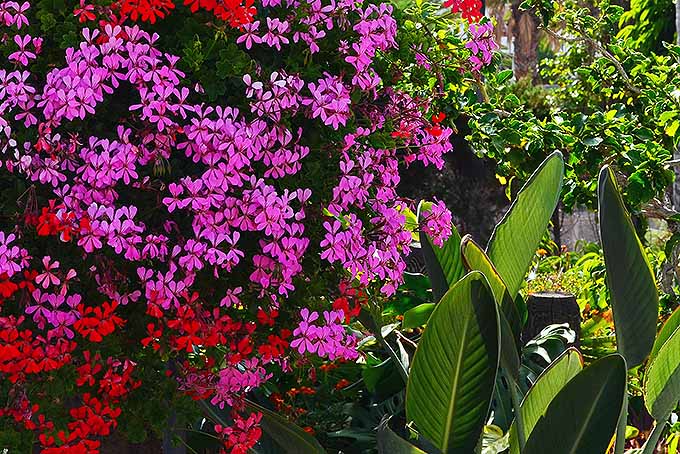
That’s moderate for South Africa, and for much of North America this means a full sun location. But for those areas that really sizzle, afternoon shade is recommended.
Or, you may like to try out some of the newer heat-tolerant varieties – the Cascade and Alpine series are good options for high heat.
Here are the conditions they like for the best flower production:
- Locate in full sun if temperatures remain below 80°F, and provide partial afternoon shade if temperatures regularly go higher.
- Plant in moderately fertile soil amended with organic material such as well-rotted manure, worm castings, or mature compost with a sprinkle of bone meal mixed in.
- Ensure all garden beds, borders, and containers have good drainage.
- Consistent watering is needed to maintain a moderate level of moisture, particularly with containers – plants that get a lot of air circulation will require more frequent watering.
- If possible, water in the morning and avoid watering in the late afternoon or evening.
- Use an all-purpose, slow release fertilizer with a 10-10-10 formula as part of their care.
- Regular deadheading encourages a steady supply of flower buds, although many varieties are now self-cleaning.
Overwinter for Spring Stock
To overwinter pelargoniums, a couple of options are available.
One is to bring them inside as houseplants and set in a bright, but cool, windowsill for the winter.
Keep these tips in mind:
- Bring plants inside just before the first frost, prune to reduce size by 1/3, and reduce watering until spring arrives.
- In late winter, trim another 1/3 of the growth and set in a warm, sunny location.
- As new growth emerges, give a diluted drink (1/3 strength) of an all-purpose liquid fertilizer such as 10-10-10.
- Once warm weather arrives, transplant out to the garden.
Another option is to let them go dormant over winter by sheltering containers before the first frost arrives.
- Trim plants by 1/3 of their volume.
- Place containers in a cool, dark corner of the basement, root cellar, garage, or any frost-free location.
- Reduce watering, but don’t eliminate it completely. Give plants small sips monthly until the end of winter.
- As the days start to lengthen, trim another 1/3 of their growth and move containers into a bright, cool location while continuing frost protection.
- Add a slow release all-purpose 10-10-10 fertilizer and increase watering to once weekly. A good fertilizer choice is this 33-pound bag of Greenview, available on Amazon.

Lebanon Seaboard Corporation All-Purpose Fertilizer
- When spring arrives, move into a sunny location in the garden.
We recommend dormant overwintering instead of the houseplant route, as it tends to promote the most vigorous bloom set the next growing season.
Pests and Problems
Pests and problems are infrequent with ivy geraniums, but there are a few issues to be on the watch for:
Edema
Edema is a physiological, non-infectious disease in which water blisters or bumps appear on leaf surfaces, then turn brown and corky as the cells erupt.
Typically caused by excess moisture, edema occurs when the soil is too wet, and the uptake of moisture is greater than what is used in transpiration.
Overwatering can cause edema, and soil should be allowed to dry out to a depth of two inches before watering again.
Cool, humid, damp, and rainy weather can also cause edema. If this is the case, symptoms will usually clear up once warm, dry weather returns.
Stem and Root Rot
Stem and root rot are also caused by excessively wet soil from overwatering or inclement weather.
Remove any infected stems and reduce watering frequency.
Ensure your containers have an adequate amount of drainage material, and for in-ground plantings, add one part sand to the planting mix.
Whiteflies and Aphids
These tiny bugs enjoy munching on leaves and stems, and are particularly problematic if plants are brought indoors to overwinter.
The first line of defense is to give your plants a good, hard spray with a strong stream of water. Some leaves and any leftover spent flowers will be knocked off, but this is okay if you are making preparations for your plants to go dormant. (If maintaining the beauty of your plants is a concern earlier in the season, skip ahead to the next option).
Allow your plants to dry out for a few days (so they aren’t dripping all over the house!) and check to see whether this has resolved the issue.
If not, or if you’d like to speed the process along, you may spray all parts of the plant with a natural pesticide made by adding a few drops of a mild dish liquid like Dawn to a spray bottle of water. Shake well and spray infected plants, paying attention to the underside of leaves and along stems.
Check again for signs of insect infestation in a few days, especially before bringing your plants inside.
Read more about dealing with aphids here or read tips on combating whiteflies here.
Brittle Stems
Due to their wonderfully expansive growth, stems can be a little fragile and break off easily.
Provide a sheltered location out of the wind and away from active children or pets.
Heat Stress
Exposure to prolonged hot weather can be an issue for these plants. During periods of extremely hot summer temperatures, flower production can slow down and stall.
Provide relief with some afternoon shade, or choose some of the more heat-tolerant varieties for areas with excessive heat.
Learn more about diseases that can affect geranium plants here.
The Container Queen
With their trailing habit, easy care and propagation, fast growth, and abundance of flowers all season long, ivy geraniums are stellar performers for any container plantings.
Simple to care for, enjoy their long-lasting blooms by providing a sheltered location, afternoon shade in hot spots, and regular watering – easy as can be!
And to ensure a steady supply of new plants for next summer’s garden, remember to overwinter your plants or take stem cuttings in the fall.
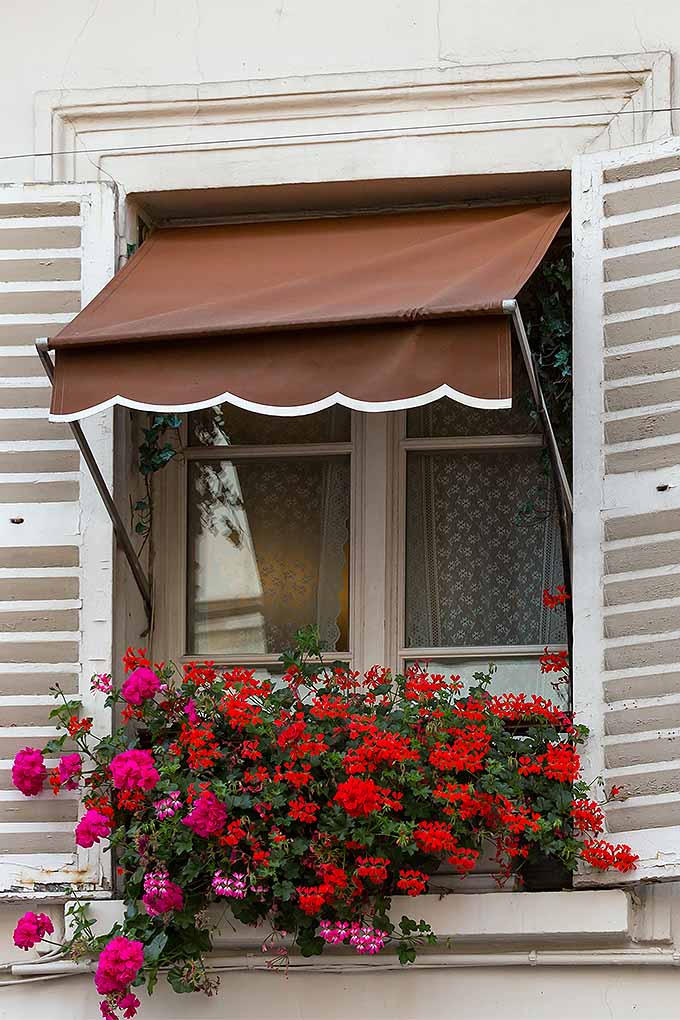
Do you folks have any favorite ivy geranium varieties? Drop us a note in the comments below and share your joy – and check out our other articles on growing these fabulous flowers.
- Are Geraniums Annuals or Perennials? Learn About Geranium Lifespans
- How to Plant and Grow Scented Geraniums
- 9 Common Geranium Diseases and How to Address Them
Product photos by Burpee, Outsidepride, joescrazyplants, Window Garden, and Lebanon Seaboard. Uncredited photos: Shutterstock.
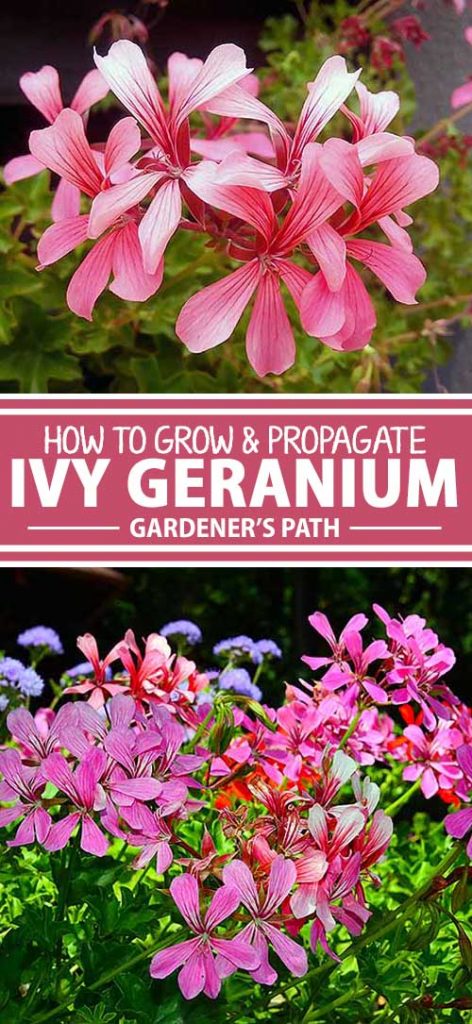
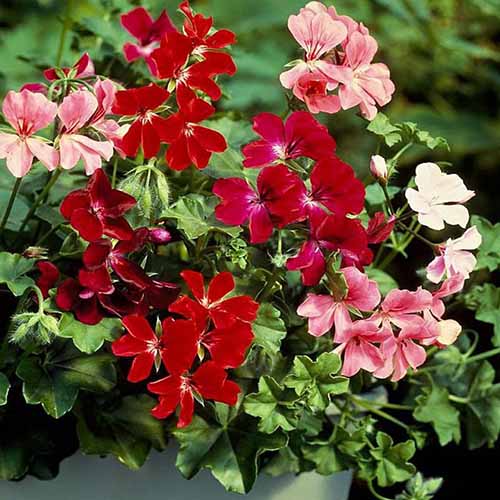
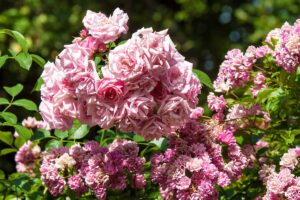

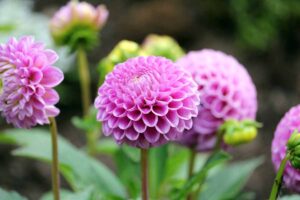
Very informative. I used to give my grandmother a hanging ivy geranium every year for Mother’s Day. She proudly hung it on her front porch to everyone to admire.
Lovely, and particularly stunning in a hanging basket! What a beautiful tradition.
Looking for variegated leaf geranium ‘Evka.’ Where to buy it?
‘Evka’ is a relatively new species Michele, first produced in the mid-90s from its parent ‘Ville de Paris’ and is popular in the UK. Try your local garden center or Amazon.uk. Thanks for asking!
Hello, any information I can get on growing Ville de Paris pelargonium.
How deep should planter box be, etc. Please help, as plants are on their way.
Ville de Paris is a beauty Judy, with lovely trailing stems of flowers. Individually, they can be grown in 4 and 6-inch pots or mixed into any container size. They require a neutral pH soil, plenty of sunlight (minimum of 6 hours daily, adequate water, and regular feeding with an all-purpose, 20-20-20 fertilizer. Deadhead lightly throughout the season for a long-lasting display. Enjoy!
The Ivy variety I think I have is heat tolerant. There are many blooms that are small and insignificant. Stems won’t grow. Spent winter in garage. I water daily via drip. Also what is the best way to grow white pelargoniums. Blooms are puny, leaves always yellowing. Nitrogen? Too crowded? What? I think white varieties are more difficult and need
some shade? Help!
I haven’t heard of white ones being more difficult to grow Kathleen, but they will appreciate some afternoon shade if they’re getting temps above 80°F. They like moist soil, so your daily drip is good. Did you transplant into a new container after winter? They may need some fresh soil and should be cut back by about 1/3 after overwintering. Also, container plants need regular applications of fertilizer to stay vibrant. Try feeding your plants with a 1/2 strength application of an all-purpose fertilizer every two weeks during the growing season – that should improve appearance and growth. Thanks for… Read more »
Some of my ivy geraniums are not trailing. Is there something I need to do?
Here are a few things I can think of Donna.
If they’re in a full sun location, try moving them to a spot where they get a few hours of afternoon shade – bright, intense light and heat stress can cause them to stall.
Also, ensure watering is consistent. And feed your hanging baskets more frequently, but at half strength using an all purpose fertilizer for flowering annuals.
You can also selectively snip a few stems back halfway to encourage new growth.
Hope that helps, thanks for asking!
Hi, question about overwintering: when you shelter the plants in a dark place, do you mean 24/7 dark? Or does it still need to have a window letting some light in?
thanks
Hey Sophie, for overwintering, plants can go into full darkness. Low light from a window is okay, provided it comes from the east or north.
But don’t place containers in front of a window – you want them alive, but in a state of dormancy with no growth happening over winter.
Thanks for your question!
H. For overwintering, does there have to be heat in the location the plant is stored or a preferred temperature?
Thanks
Hey Tracy, for overwintering, the ideal temperature is between 35 and 45 degrees F.
Thanks for asking, sorry for the slow reply!
Yes
Hello. Excellent information. Just would like to know – while planting ivy geranium, we have to leave 2/3 leaves at the top. Are the top bigger leaves to be cut in to half? Regards
Hi Sevanan, if the top leaves are too large they certainly can be cut in half. It makes them more manageable and diverts energy into root formation.
Thanks for asking!